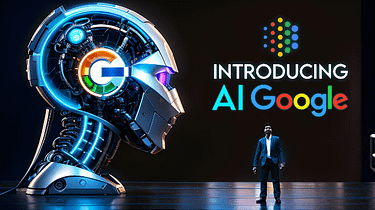[kc_row _id=”649177″][kc_column _id=”973408″][kc_column_text _id=”891316″ css_custom=”{`kc-css`:{}}”]

In the ever-evolving landscape of technology, one company's strategic decisions can send ripples throughout entire industries. Google, a pioneering force in the digital realm, has once again captured attention with its bold pivot towards artificial intelligence (AI). This move not only signals a significant shift in the company's direction but also prompts us to contemplate its broader implications, particularly on the workforce. In this article, we delve into Google's embrace of AI and the profound impact it stands to have on employment dynamics.
Understanding Google’s AI Pivot:
Google's journey with AI is not new. For years, the tech giant has been at the forefront of AI research and development, integrating machine learning algorithms into various products and services. However, recent strategic maneuvers indicate a heightened commitment to AI-driven initiatives. From restructuring internal teams to prioritizing AI-centric projects, Google is positioning itself as a leader in harnessing the potential of artificial intelligence across its ecosystem.
Key Initiatives and Investments:
Google's pivot towards AI is reflected in its significant investments and strategic initiatives. The acquisition of cutting-edge AI startups, the development of advanced AI-powered tools like language processors and image recognition systems, and the integration of AI into core products such as search algorithms and advertising platforms demonstrate the company's dedication to leveraging AI across diverse domains.
Impact on the Workforce:
While the advancement of AI holds immense promise in enhancing efficiency, productivity, and innovation, it also raises concerns about its impact on employment. Google's strategic pivot towards AI is likely to reshape the workforce in several ways:
- Automation of Routine Tasks: As AI systems become more sophisticated, mundane tasks across various industries are susceptible to automation. This could lead to job displacement for workers engaged in repetitive and routine activities.
- Demand for AI Skillsets: Conversely, the proliferation of AI creates a growing demand for professionals skilled in machine learning, data science, and AI development. Google's emphasis on AI-driven projects is likely to fuel this demand, offering opportunities for individuals with the requisite expertise.
- Reskilling and Upskilling: Recognizing the evolving nature of the workforce, Google and other tech companies are increasingly investing in reskilling and upskilling initiatives. Programs aimed at equipping employees with AI-related skills can help mitigate the negative impacts of automation by facilitating transitions to new roles and industries.
- Emergence of New Job Roles: The AI revolution is also expected to give rise to novel job roles and career paths. Positions such as AI ethicists, data privacy specialists, and AI trainers may become increasingly prevalent as organizations navigate the ethical, regulatory, and societal implications of AI deployment.
Conclusion:
Google's strategic pivot towards AI heralds a new era of technological innovation with far-reaching implications for the workforce. While the integration of AI promises to drive efficiencies and unlock new opportunities, it also necessitates a proactive approach to address potential challenges such as job displacement and skill mismatches. By embracing AI responsibly and investing in the reskilling of its workforce, Google and other stakeholders can navigate this transformative period with resilience and inclusivity, ensuring that the benefits of AI are realized equitably across society.
As Google continues to chart its course in the AI landscape, the workforce must adapt and evolve in tandem, harnessing the power of artificial intelligence to shape a more sustainable and prosperous future.
[/kc_column_text][kc_button text_title=”Read more” _id=”162254″ link=”https://futurism.com/the-byte/google-ceo-ai-pivot-layoffs||_blank”][/kc_column][/kc_row]